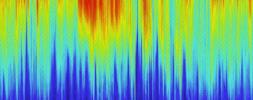The SNMREC Preferred Partner Program is an opportunity for our industry partners to collaborate more fully with the Center. This program is designed to dedicate SNMREC experts and resources to individual industry partner development needs.
Environmental Assessment

Although the concept of deploying electrical generating systems in the Florida Current goes back at least a half-century, there have been only a few scale-models tests over the years, and these were of very limited duration with only a single device at a time. In contrast, full-scale, commercial deployments of the future are likely to involve arrays of devices, possibly numbering in the thousands, with networked cable-to-shore systems to connect the power generated to the electrical grid. At this scale, it is clear that the interaction between the equipment and the marine environment will be two-way, with questions arising in both directions:
- How will commercial-scale arrays of generating devices affect the marine environment?
- How will the marine environment affect the equipment?
One advantage of the SNMREC strategy of deploying single-device prototypes for testing purposes is that these questions can be addressed on very small scales before the investment in arrays is made. It is clear that single devices will have negligible lasting effect on the large-scale marine environment (although the marine environment will undoubtedly affect them), but small scale influences can be measured and scaled up to predict the effects of arrays.
Environmental stewardship embodies, first and foremost, the natural-world version of the Hippocratic Oath to “do no harm.” In the context of using open-ocean currents such as the Florida Current for the purpose of generating electricity, there is some potential for harm to marine life, and this must be understood and properly mitigated. Concerns which arise from the sea floor to the surface include, for example:
- What effects will there be on benthic habitat from anchor systems and potential changes in sediment transport?
- Within the water column, will pelagic fishes be disturbed by (or attracted to) the generating equipment?
- How will acoustic effects on the ocean be perceived by noise-sensitive species?
- Will electrical cables be an issue with respect to sharks and other electroreceptive sea creatures?
- What is the potential for strikes of pelagic species (notably protected mammals and endangered sea turtles) with the equipment (particularly turning rotors)?
While the range of these important questions is daunting, SNMREC’s approach to marine hydrokinetic energy implementation offers the potential of small-scale experiments to investigate these issues with care and to use results to develop mitigation strategies. Work on the more compelling problems (e.g., endangered sea-turtle issues) has begun.



